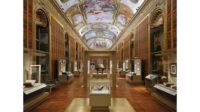Click on the slide show icon to see additional photos.
A significant contribution to modern building design and science was celebrated on April 29 in the daylit halls of the Smithsonian National Museum of American History [recently renovated by Skidmore, Owings & Merrill] in Washington, D.C. Joel Spira, inventor and developer of the solid-state electronic dimming device, as well as chairman and founder of Lutron Electronics (1961), donated a range of his company’s most innovative and historic materials to the museum’s Electricity Collection—home of Thomas Edison’s earliest light bulbs.
“The tools of everyday life, like light switches, help us understand and document an ever-changing technological society,” says Hal Wallace, the museum’s Electrical Curator. Until now, he explains, “we really didn’t have much from the mid- to late-twentieth century. The items selected represent nearly 50 years of lighting-control technology, from early solid-state rotary dimmers up to modern programmable devices that operate by remote control or by using computer software.” The gift also includes Spira’s handwritten inventor’s notebook, historic photographs, early retail displays, and advertisements.
When asked why he invented these things, the Brooklyn-born, 83-year-old Spira—credited with 266 design patents and 226 utility patents—recounts that after a stint working in Navy radar during World War II, he became intrigued with a small solid-state device called a silicon-controlled rectifier that can control a lot of power. “I had always been fascinated with lighting,” says Spira, “So I thought why can’t it control a light bulb? I wired it up and indeed it did!” The rest, as they say, is history.





